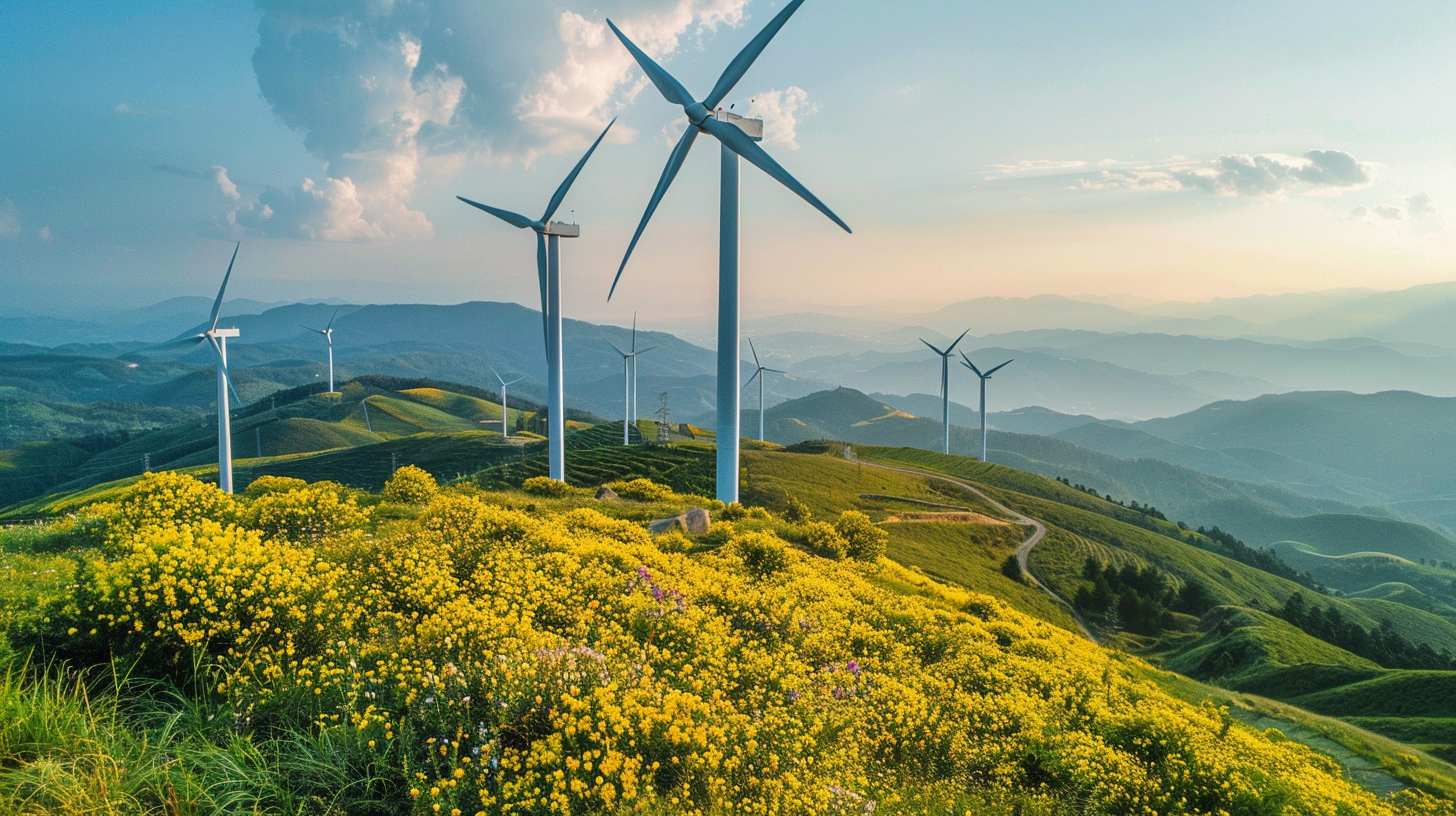Table of Contents Show
Isn’t it time we considered how the renewable revolution is reshaping our world? As we witness a global shift towards clean energy, we’re not just talking about reducing carbon emissions; we’re exploring a transformative approach that could redefine our economic, environmental, and social landscapes. From the surge in solar power to the pivotal role of nuclear energy, the journey is as complex as it is critical. But how are global initiatives and consumer power shifts driving this change, and what does the future hold for our energy consumption? Join us as we uncover the layers behind the shift to clean energy globally.
Key Takeaways
- Transitioning to clean energy is crucial for environmental sustainability and public health.
- Renewable energy sources like solar, wind, and hydro are key to reducing pollution and dependence on fossil fuels.
- Global growth in clean energy is driven by technological advancements and successful country-specific adoption models.
- Overcoming financial, infrastructural, and policy challenges is essential for the worldwide clean energy transition.
The Urgency of Change
The critical need to switch to clean energy stems from the undeniable fact that every moment we delay exacerbates the planet’s environmental crisis. We’re standing at a crossroads, where the path we choose not only defines our relationship with the environment but also our commitment to a future where freedom and sustainability coexist. Our collective actions today are pivotal in ensuring that we don’t just survive but thrive.
Embracing clean energy isn’t just about reducing emissions or combating climate change; it’s about securing a future where our energy needs don’t compromise our health, environment, or our children’s prospects. It’s about breaking free from the shackles of finite resources that have historically dictated geopolitical dynamics and economic stability. Investing in renewable sources like wind, solar, and hydro power means we’re not just betting on a healthier planet, but we’re also championing a more equitable world where energy isn’t a privilege but a right.
We’ve got the technology, the know-how, and the momentum to make this switch. What we need now is the collective will. Every action counts, from the choices we make as consumers to the policies we demand from our leaders. It’s time we demand a future that echoes our desire for freedom, choice, and sustainability.
Let’s not wait for tomorrow to do what can be done today. The switch to clean energy is not just an environmental imperative; it’s a statement of our values, our vision for the future, and our unwavering belief in progress. Together, we can turn the tide, ensuring a cleaner, greener, and more liberated world for generations to come.
Historical Energy Consumption
Reflecting on our past energy choices underscores why moving towards clean energy is imperative for our future. We’ve long relied on fossil fuels—coal, oil, and natural gas—to power our lives, industries, and economies. This historical consumption has not only been unsustainable but has also led to significant environmental and health consequences. We’re at a point where continuing down this path isn’t just irresponsible; it’s a direct threat to our freedom to live on a healthy planet.
Our journey through the energy landscape shows a heavy dependence on resources that are finite and polluting. For centuries, coal was king, fueling the Industrial Revolution and providing a cheap, albeit dirty, energy source. As we advanced, oil and natural gas took the forefront, powering our cars, homes, and businesses. This reliance has shaped our world, but it’s also shackled us to fluctuating global markets and geopolitical tensions, compromising our energy independence and security.
We’ve seen the impact. Air and water pollution, climate change, and habitat destruction are just the tip of the iceberg. These aren’t just environmental issues; they’re threats to our freedom, health, and well-being. It’s clear that our historical energy consumption patterns are unsustainable. We can’t change the past, but we’ve got the power to shape our future. Shifting to clean energy isn’t just an option; it’s a necessity for preserving our planet and ensuring our freedom to thrive. Let’s embrace this challenge, not as a burden, but as the opportunity of a lifetime.
Defining Clean Energy
Before we explore the future of our planet’s energy, let’s clarify what we mean by ‘clean energy’. It encompasses a range of sources that don’t pollute our atmosphere, including solar, wind, and hydroelectric power. Understanding these types, their benefits, and the global outlook for clean energy will set the stage for our discussion.
Types of Clean Energy
Clean energy encompasses a variety of renewable and non-polluting sources, aiming to minimize environmental impact and foster sustainability. We’re talking about harnessing the power of the sun, wind, water, and the earth itself to fuel our lives. Solar energy uses panels to capture sunlight, converting it into electricity without harmful emissions. Wind energy relies on turbines to turn breezes into power, offering a clean alternative that’s always flowing. Hydroelectric power generates energy from flowing water, tapping into the natural cycle of our rivers and streams. Geothermal energy, on the other hand, dives deep, harnessing the Earth’s internal heat. Together, these sources promise a future where we’re not just surviving but thriving, free from the chains of pollution and environmental degradation.
Benefits of Clean Energy
Understanding the different types of clean energy sets the stage for us to explore their numerous benefits, which go beyond reducing pollution and fostering sustainability. Here’s a snapshot:
| Benefit | Description |
|---|---|
| Healthier Environment | Minimizes exposure to harmful pollutants. |
| Energy Independence | Reduces reliance on imported fuels. |
| Job Creation | Spurs growth in green tech sectors. |
| Economic Savings | Lowers energy costs in the long run. |
| Innovation Drive | Encourages technological advancements. |
Embracing clean energy isn’t just about doing good; it’s about giving us the freedom to live healthier, more self-sufficient lives. It’s an investment in our planet’s future and in our own, opening up possibilities we’ve only begun to imagine. Let’s take control, together.
Global Clean Energy Outlook
As we shift toward a sustainable future, it’s essential to grasp what clean energy encompasses and why it’s crucial to our global energy outlook. Clean energy represents the liberation from traditional, pollution-heavy energy sources, offering a path to a healthier planet and more autonomous energy production. Here’s a snapshot:
- Solar power, harnessing the sun’s endless energy
- Wind energy, capturing the earth’s natural airflows
- Hydroelectric power, utilizing the force of flowing water
- Biomass, converting organic materials into electricity
- Geothermal energy, tapping into the earth’s internal heat
Embracing these technologies not only aligns with our desire for freedom from fossil fuels but also propels us toward a more sustainable and independent future. Shifting to clean energy isn’t just an option; it’s a necessity for our planet’s health and our own.
Global Renewable Initiatives
Globally, we’re increasingly embracing renewable initiatives to shift towards a more sustainable energy future. It’s a journey that’s not just about reducing carbon footprints; it’s about gaining the freedom to generate, use, and share energy in ways that were unimaginable just a few decades ago. We’re moving away from the centralized, one-way power systems, opening a future where energy is cleaner, more democratic, and accessible to everyone.
We’re seeing countries around the world setting ambitious targets to increase their share of renewable energy. From wind farms sprawling across vast plains to harnessing the immense power of our oceans, these initiatives are a sign of our collective desire for change. It’s not just about the technology; it’s about building communities around sustainable practices, creating jobs that don’t compromise our planet’s health, and ensuring that no one is left behind in this shift.
One of the most exciting aspects of this change is the innovation in energy storage and grid management. We’re developing systems that can store renewable energy more efficiently, making it possible to keep the lights on even when the sun isn’t shining or the wind isn’t blowing. This is critical for ensuring a reliable and constant energy supply, giving us the freedom to live our lives without worrying about power outages.
As we push forward with these renewable initiatives, we’re not just protecting the environment; we’re setting the stage for a future where energy is a tool for empowerment, not a source of constraint. It’s a collective journey towards a brighter, cleaner world, and everyone’s invited to be a part of it.
Solar Power Surge
As we turn our focus to the solar power surge, it’s clear that recent advancements in solar technology have played a pivotal role. These innovations are driving global solar adoption rates to unprecedented levels. We’ll explore how these developments are reshaping the energy landscape worldwide.
Solar Technology Advances
In recent years, we’ve witnessed a significant surge in solar technology advances, marking a pivotal shift towards more sustainable energy sources. This movement guarantees us from traditional energy dependencies, embracing the freedom of renewable power. Here’s how innovation is driving us forward:
- Perovskite Solar Cells: Offering higher efficiency rates and lower production costs.
- Bifacial Solar Panels: Generating power from both sides to enhance energy capture.
- Floating Solar Farms: Utilizing water bodies to save land and cool the panels.
- Solar Storage Solutions: Advanced batteries improving energy storage for round-the-clock use.
- Transparent Solar Panels: Integrating into windows, allowing buildings to generate their own power.
These advancements assure we’re not just dreaming of a cleaner future; we’re actively building it, hand in hand with freedom and sustainability.
Global Solar Adoption Rates
Reflecting on the past decade, we’ve seen solar power’s global adoption rates soar, fundamentally reshaping our energy landscape. This surge isn’t just about cleaner air or reducing carbon footprints—it’s about breaking free from the chains of traditional energy sources. We’re now harnessing the sun’s boundless energy, empowering communities worldwide, and fostering economic independence. Nations once reliant on imported oil are finding liberation in solar farms that sprawl across their lands, tapping into a resource that’s as abundant as it is clean. The momentum is undeniable. Prices for solar installations continue to plummet, making it an accessible option for more people than ever before. We’re not just adopting a new power source; we’re embracing a future where energy freedom is within our grasp.
Wind Energy Growth
We’ve observed a noteworthy surge in wind energy adoption, marking a pivotal shift toward renewable resources. This growth isn’t just about embracing an alternative to fossil fuels; it’s about securing our energy freedom. We’re stepping away from the shackles of finite resources, moving towards a future where our power is as boundless as the wind itself.
This change has been remarkable, driven by both advancements in technology and a global commitment to sustainable development. Here’s a closer look at why wind energy’s growth is a cornerstone of our collective journey towards energy independence:
- Technological Advancements: Innovations in turbine design and efficiency have notably lowered the cost of wind energy, making it more competitive with traditional power sources.
- Government Incentives: Many countries have introduced subsidies and tax incentives to encourage the development of wind farms, recognizing the dual benefits of energy security and environmental protection.
- Rising Investment: There’s been a noticeable uptick in both public and private investment in wind energy projects. This financial backing is critical for large-scale deployment.
- Growing Consumer Demand: As awareness of climate change increases, so does the demand for cleaner, renewable energy sources from the public and businesses alike.
- International Collaboration: Nations are coming together, sharing knowledge and resources to accelerate the growth of wind energy on a global scale.
Hydroelectric Power Potential
As we explore the domain of hydroelectric power, it’s essential we assess its global capacity, understand the environmental impacts, and consider the role of innovative technologies. We’ll examine how these aspects can drive or hinder its adoption as a key component of the world’s clean energy mix. Our focus will encapsulate the balance between leveraging hydroelectric power’s potential and mitigating its ecological footprint.
Global Hydroelectric Capacity
Hydroelectric power holds tremendous potential globally, with the capability to greatly expand renewable energy production. We’re looking at a future where our thirst for energy could be quenched without compromising our love for freedom and the environment. Here’s why:
- Abundant resources available across continents
- Sustainable power generation without depleting resources
- Reliable energy supply, less vulnerable to market fluctuations
- Cost-effective in the long term, reducing dependence on fossil fuels
- Scalable, from small community projects to massive dams
This isn’t just about generating electricity; it’s about empowering communities and nations to be self-sufficient. By tapping into hydroelectric power, we’re not just preserving our planet; we’re securing our future freedom to live, innovate, and thrive on our own terms.
Environmental Impacts Assessed
While hydroelectric power offers numerous benefits, it’s important to examine the environmental impacts it may have. We’re committed to freedom in our energy choices, ensuring we don’t overlook the consequences of our decisions. Here’s a concise look at the environmental considerations:
| Impact Area | Description |
|---|---|
| Ecosystem Disruption | Dams can alter water flow, affecting local wildlife habitats. |
| Water Quality | Reservoirs may lead to reduced oxygen levels in water. |
| Greenhouse Gases | Decomposing plants in reservoirs emit methane. |
| Sedimentation | Dams trap sediments, impacting water quality downstream. |
| Biodiversity Loss | Construction can lead to habitat loss for many species. |
We’re determined to tread lightly on our planet, ensuring our energy freedom doesn’t cost the earth its vitality.
Innovative Technology Advancements
Exploring innovative technology advancements, we’re releasing new potentials in hydroelectric power to address environmental challenges. As we dive deeper, it’s clear that these innovations could greatly pivot our energy systems towards sustainability, offering freedom from fossil fuels. Here are key advancements:
- Enhanced turbine efficiency, reducing environmental impact
- Modular hydro designs, allowing for scalable installations
- Advanced materials for longer lifespan and reduced maintenance
- Smart grid integration, optimizing energy distribution
- Low-impact hydroelectric options, preserving natural habitats
These breakthroughs signal a future where our energy needs align more closely with the planet’s health. By embracing these technologies, we’re not just pivoting to cleaner power; we’re opening doors to a future where energy freedom and environmental stewardship go hand in hand.
Innovations in Energy Storage
We’re stepping into a new era with innovative energy storage solutions that are essential for harnessing renewable energy more efficiently. As we embrace the renewable revolution, it’s clear that the shift to access clean energy anytime, anywhere, is paramount. Innovations in energy storage are paving the way for this necessity, ensuring that the power generated from the sun and wind can light up our homes and power our industries, even when the sun sets or the wind doesn’t blow.
Lithium-ion batteries have long been at the forefront of energy storage technology, but we’re now seeing a surge in alternative solutions that promise greater efficiency and sustainability. Solid-state batteries, with their higher energy density, are emerging as a game-changer, offering the potential for longer-lasting power storage without the risk of fire associated with traditional batteries. This leap in technology means we can store more energy in smaller, safer packages, a critical step towards energy independence.
Moreover, we’re exploring beyond batteries with innovations like gravity storage and compressed air energy storage. These technologies utilize the physical principles of gravity and air compression to store energy, providing a clean, low-cost alternative to battery storage. They’re not just concepts; they’re becoming reality, offering scalable storage solutions that can support entire communities.
The shift to clean energy isn’t just about generating renewable power; it’s about storing and using that power in the most efficient way possible. With these innovative storage solutions, we’re not just facing a future where clean energy is possible; we’re making it accessible, reliable, and, most importantly, free from the constraints of traditional energy sources. Together, we’re not just witnessing a revolution; we’re actively driving it.
Challenges to Adoption
As we shift our focus to the hurdles in adopting clean energy, it’s clear we’re up against significant challenges. Financial hurdles, infrastructure gaps, and policy barriers stand as formidable obstacles in our path. Understanding and addressing these issues is vital for the global shift to sustainable energy sources.
Financial Hurdles
One of the biggest obstacles we face in adopting clean energy globally is the significant financial investment required. Shifting to renewable sources involves not just upfront costs but ongoing financial commitments that can deter even the most freedom-loving among us.
Here’s a concise look at these hurdles:
- High initial costs for renewable energy installations.
- Lack of accessible financing options for individuals and small businesses.
- Market volatility affecting long-term investment stability.
- Insufficient government incentives to bridge the cost gap.
- The economic burden of shifting existing infrastructure.
We’re all aiming for a future where clean energy is the norm, but the path there demands we navigate these financial challenges with determination and innovative solutions. It’s about securing our freedom to live sustainably, in harmony with our planet.
Infrastructure Gaps
Beyond financial hurdles, our journey to adopt clean energy is also hampered by significant infrastructure gaps. These gaps act like invisible chains, holding us back from freely moving towards a future that promises cleaner air, water, and soil. To shed light on these obstacles, here’s a quick overview:
| Challenge | Impact | Solution |
|---|---|---|
| Grid Modernization | Limits renewable integration | Upgrade & adapt energy grids |
| Storage Capabilities | Restricts energy reliability | Invest in battery technology |
| Transmission Lines | Constricts energy distribution | Expand & innovate networks |
| Charging Infrastructure | Slows EV adoption | Increase charging stations |
| Skilled Workforce | Delays projects and maintenance | Enhance training programs |
It’s clear we’ve got our work cut out for us, but overcoming these gaps means stepping closer to the freedom clean energy promises.
Policy Barriers
Traversing the bureaucratic maze, policy barriers impede our global shift towards clean energy adoption. We’re facing a multitude of challenges, ranging from outdated regulations to a lack of incentives, stifling our progress. It’s critical we identify and address these issues head-on to secure a smooth shift. Here are the main culprits:
- Inconsistent policy frameworks across regions
- Insufficient financial incentives for renewable energy investments
- Overregulation in the energy sector
- Lack of support for research and development in clean energy technologies
- Slow permit processes for renewable energy projects
We’ve got to push for policy reforms that not only encourage but also accelerate the adoption of clean energy. It’s about securing our freedom to choose a sustainable future, unshackled from the constraints of outdated energy policies.
Economic Impacts
How does the shift toward clean energy influence global economies, and what are the potential long-term benefits and challenges? We’re diving deep into the economic impacts of the renewable revolution, a movement that promises not just a cleaner planet but a reshaped economic landscape.
The move to clean energy is sparking significant job creation. As we pivot away from fossil fuels, a surge in demand for skilled labor in renewable sectors is evident. Solar panel installers, wind turbine technicians, and countless other roles are burgeoning, setting the stage for a vibrant job market. This isn’t just about numbers; it’s about offering people the freedom to choose careers that sustain both their families and the planet.
Furthermore, investing in renewable energy technologies stimulates economic growth. This influx of capital into clean tech boosts innovation, driving down costs and making renewable energy more accessible to everyone. It’s a cycle of growth that benefits all, reducing energy bills and freeing up household income for other needs.
However, we can’t ignore the challenges. The shift requires significant upfront investment, and there’s the matter of transitioning workers from declining industries. Yet, these hurdles don’t overshadow the fact that the economic benefits of clean energy far outweigh the initial costs. We’re looking at a future where economies thrive on sustainability, innovation, and freedom of choice.
Policy and Regulation
Exploring the clean energy shift necessitates robust policy frameworks and regulations to guarantee a smooth and equitable change. As we investigate this shift, it’s clear that without thoughtful policies and regulations, we risk falling short of our collective ambitions for a cleaner, sustainable future. We’re passionate about freedom – the freedom to innovate, the freedom to choose, and the freedom to thrive in a world powered by renewable energy. To achieve this, we must advocate for policies and regulations that empower individuals and communities.
Key policy and regulation areas include:
- Incentive Programs: Financial incentives, such as tax credits and rebates, to encourage both individuals and businesses to adopt renewable energy solutions.
- Grid Modernization: Investments in grid infrastructure to accommodate the variable nature of renewable energy sources and guarantee reliability.
- Building Codes: Updated building codes that mandate or highly encourage the use of energy-efficient designs and technologies.
- Renewable Portfolio Standards (RPS): Mandates for utilities to source a certain percentage of their energy from renewable sources, driving demand for clean energy.
- Open Access to the Grid: Policies ensuring that small-scale renewable energy producers can connect to and sell energy back to the grid, empowering local communities and individuals.
We’re at a pivotal moment in our journey towards a renewable future. By championing policies and regulations that prioritize freedom, fairness, and sustainability, we pave the way for innovation and make certain that the clean energy revolution benefits everyone. Let’s embrace this opportunity to shape a world where clean energy is not just a choice, but a fundamental right.
Renewable Energy Success Stories
We’ve witnessed remarkable success stories across the globe as communities and nations harness the power of renewable energy to fuel their futures. These tales of transformation are not just about shifting energy sources; they’re about reclaiming power, ensuring our communities thrive on clean, sustainable energy that’s by the people, for the people.
Take Denmark, for example, a pioneer in wind energy, now aiming to cover all its electricity needs with renewables by 2030. It’s not just about change but about people coming together, embracing wind farms, and leading the charge towards a sustainable future. Similarly, Costa Rica has been running on nearly 100% renewable energy, showcasing how commitment to clean energy can turn a nation into a beacon of sustainability.
In Africa, Kenya’s embrace of geothermal power has not only reduced reliance on fossil fuels but also sparked economic growth, proving that renewable energy is a catalyst for freedom and prosperity. These aren’t isolated incidents; they’re part of a growing trend where communities, fed up with the constraints and pollution of fossil fuels, are turning to renewables to secure their energy independence.
We’re part of this revolution. Every solar panel installed, every wind turbine erected, is a step towards a future where we’re not just passive consumers of energy but active participants in creating a sustainable, free world. It’s clear: the shift to renewable energy isn’t just possible; it’s happening, driven by the people’s desire for a cleaner, freer future.
The Role of Nuclear Power
While celebrating the strides made with wind, solar, and geothermal energies, it’s also important to contemplate nuclear power’s significant role in the global shift toward clean energy sources. As advocates for a cleaner, safer planet, we recognize the need for a diverse energy portfolio. Nuclear power, with its ability to provide large-scale, reliable energy with zero carbon emissions during operation, stands out as a pivotal component of our energy freedom.
Nuclear power offers several advantages that complement renewable sources:
- Reliability: Unlike solar and wind, nuclear power does not depend on weather conditions, ensuring a stable energy supply.
- High Energy Density: A small amount of nuclear fuel can produce a vast amount of energy, reducing the need for extensive land use.
- Low Greenhouse Gas Emissions: Nuclear energy produces minimal greenhouse gases once plants are operational, contributing to our fight against climate change.
- Long-term Solution: With advancements in reactor design and fuel recycling, nuclear power can sustain our energy needs far into the future.
- Global Availability: Nuclear technology is accessible worldwide, providing a path to energy independence for many countries.
We’re at a pivotal moment where embracing all forms of clean energy is essential to our liberty to live on a healthy planet. Nuclear power, with its unique benefits, plays an indispensable role in this journey. By supporting nuclear alongside renewables, we’re not just choosing a cleaner energy mix; we’re choosing freedom from pollution, energy scarcity, and the geopolitical constraints of fossil fuels. Together, let’s champion an energy future that values diversity, reliability, and sustainability.
Consumer Power Shifts
Increasingly, consumers are leveraging their purchasing power to demand cleaner, more sustainable energy options, signaling a major shift in global energy markets. We’re witnessing a remarkable transformation where our collective choices are driving the energy sector towards greener alternatives. This isn’t just about choosing renewable energy sources; it’s a declaration of our desire for freedom from pollution, high energy costs, and the geopolitical complexities tied to fossil fuels.
As we embrace solar panels for our homes, invest in electric vehicles, and support businesses committed to sustainability, we’re not just passive consumers anymore. We’re active participants in shaping a future where clean energy is the norm, not the exception. Our demands are pushing companies and governments to rethink their energy strategies, prioritizing innovation and sustainability over traditional, environmentally harmful practices.
This shift isn’t merely a trend; it’s a powerful movement towards autonomy and environmental stewardship. By choosing renewable energy, we’re reducing our dependency on external energy supplies, enhancing our security, and promoting a healthier planet for future generations. It’s a clear message that we value freedom – the freedom to live in a world that prioritizes clean air, water, and soil over short-term profits and outdated energy models.
Our collective action is proof that when we come together, we can drive significant change. It’s a reminder that each of us holds the power to influence the global energy landscape, simply by making informed choices. As we continue on this path, we’re not just shifting to renewable energy; we’re reclaiming our right to a sustainable, empowered future.
Future Energy Landscapes
Acknowledging the power shifts driven by consumer demands, let’s now explore how these changes are shaping the energy landscapes of tomorrow. As we embark on this shift, it’s clear that our journey towards clean energy isn’t just a choice—it’s a declaration of our commitment to freedom and sustainability. We’re not just changing the sources of our power; we’re transforming the very fabric of our societies.
The future energy landscapes we’re envisioning are rich with innovation and resilience. Here’s what they might include:
- Decentralized Energy Systems: Localized, renewable energy sources that empower communities to become self-sufficient and less reliant on large-scale utility providers.
- Smart Grids: Advanced grid technologies that optimize energy distribution, reducing waste and increasing efficiency.
- Energy Storage Breakthroughs: Innovations in battery technology that make storing renewable energy more feasible and efficient, ensuring a steady supply even when the sun isn’t shining or the wind isn’t blowing.
- Electric Vehicle Expansion: A significant increase in the use of electric vehicles, supported by widespread charging infrastructure, further reducing our reliance on fossil fuels.
- Global Collaboration: Nations coming together to share technologies, strategies, and resources, ensuring that the benefits of the renewable revolution are accessible to all.
As we forge ahead, it’s important to remember that this isn’t just about energy; it’s about shaping a world where freedom, sustainability, and innovation are intertwined. Our choices today will determine the landscapes of tomorrow, and it’s up to us to make them as vibrant and resilient as possible.
Conclusion
As we stand on the brink of an energy revolution, our collective journey towards clean energy mirrors the dawn breaking over a stagnant night. Just as the sun casts away shadows, so does our shift towards renewables illuminate a future of possibilities. We’re weaving a tapestry of solar arrays, wind farms, and hydro plants, each confirmation to our resolve. In embracing this change, we’re not just powering our homes; we’re rekindling our hope for a sustainable world. Together, we’re turning the tide.







